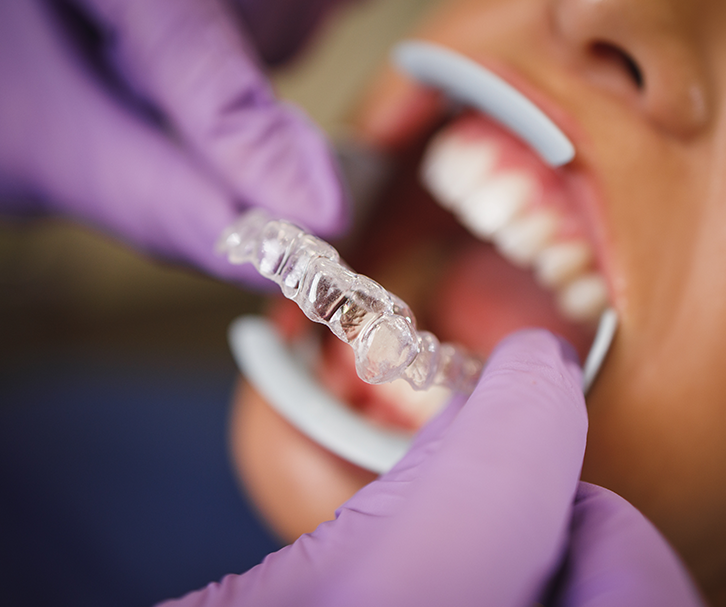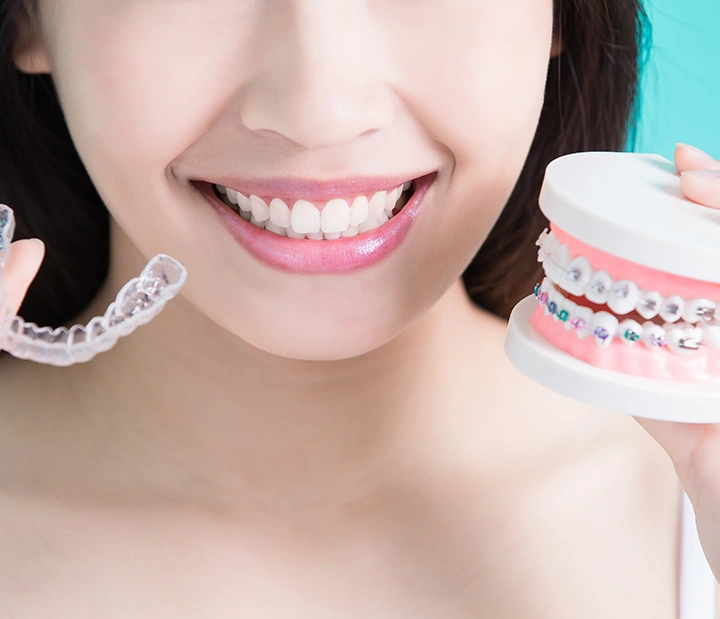Invisalign Moderate London

The modern Invisalign orthodontic therapy at Art Dentistry can help teeth of various complexity and problems to be aligned in a suitable posture. This is accomplished by integrating artificial intelligence, 3D printing, and scanning technology to produce a line of transparent plastic aligners. Invisalign aligners also referred to as clear braces, straighten teeth, improving their function and making it much easier to maintain proper oral care!
Invisalign and similar clear brace technologies, such as SureSmileTM, are examples of short-term orthodontic systems that shift teeth fast without sacrificing stability or reliability. These systems are meant to be provided by general dentists and orthodontists with specialist training.
Thanks to the knowledge and direction of our staff, we at Art Dentistry are happy to provide this orthodontic treatment to our patients in London and the surrounding locations.
How Do Clear Braces And Invisalign Aligners Function?
For the patient's records, an X-ray, several photos, and a 3D scan of the patient's teeth are first obtained. Clincheck VideosTM are three-dimensional computer visuals produced by InvisalignTM with the use of cutting-edge artificial intelligence technology trained by millions of patients who have already undergone treatment with the system. These drawings are used to generate a sequence of precisely fitting aligners using 3D printing technology. Wearing each set of aligners enables the teeth to advance into the ideal position by a predefined amount and prepares them for the next set, as demonstrated in the Clincheck VideoTM.

What Is Moderate Invisalign?
The most advanced, precise, and user-friendly aligner system for adult patients was introduced by Invisalign technology, and it's called Invisalign Moderate.
The degree of tooth misalignment and the type of tooth movement necessary during an Invisalign treatment determine how many aligners are required. More aligners are needed the longer the Invisalign treatment takes to finish and, as a result, the higher the patient expenses. The groups that currently make InvisalignTM's service offerings are as follows:
It is possible to get seven sets of top and bottom aligners with Invisalign Express, sometimes referred to as i7.
- With Invisalign Lite, there can be a maximum of 14 top and bottom aligner sets.
- The most recent categorisation of the Invisalign procedure is Invisalign Moderate, which has a maximum of 20 sets of top and bottom aligners.
- Use Invisalign Comprehensive or Full if more than 20 sets of top and bottom aligners are needed.

What Is The Cost Of An Invisalign Moderate Treatment Based In London?
The cost of Invisalign treatment varies based on the clinic, just like it does for any other dental procedure. The complexity of the process, the number of aligners needed to finish a treatment plan, the number of appointments, and the amount of time needed to achieve a satisfactory result.
A few dentist visits are necessary before an Invisalign course is completed. For the ease of our central London-based Art Dentistry Invisalign patients, we have introduced fixed pricing special offer packages for some of our Invisalign treatments. This gives our patients more clarity and makes it easier for them to comprehend the costs of Invisalign, allowing them to more securely plan their financial future.
Invisalign's Moderate Cost And Available Payment Options
In order to better support our patients during their Invisalign treatment, Art Dentistry has developed three additional payment methods.

1. Pay As You Go
Once the Invisalign procedure begins, the patient is responsible for the following expenses:
- The £400 down payment for the Invisalign Clinicheck video setup is required.
- The second instalment of £899 is due when the patient authorises the video and asks that the aligners be created.
- Every four to eight weeks, a third payment of £350 will be made until the total cost of the Invisalign treatment is paid.
- Depending on the Invisalign package, the cost of the third instalment will vary.
- The Invisalign Moderate package includes six payments totalling £425.

2. A Zero-Interest Loan For Eighteen Months
Patients can qualify for an 18-month, 0% financing loan to cover all or part of the cost of their Invisalign treatment.
- While the clinic offers support during the application process, it is not involved in or has any influence over the financing acceptance process.
- The bank decides whether or not to grant the loan after reviewing the applicant's credit history.
- Upon acceptance of the application, the patient begins monthly bank payments.
For example, the monthly cost of an 18-month application would normally be the following:
- £183 per month for the Invisalign Moderate plan.
5% Off If The Whole Amount Is Paid In Advance
Patients who pay the entire treatment cost at the time of service are eligible for a discount of 5%!

The following are all of the special offers for the invisible moderate package:
- Excellent assistance and care for patients.
- The needs of the patient always come first.
- A free in-office consultation for Invisalign to establish eligibility (worth £50).
- Offering a written treatment plan that is based on costs.
- Free 3D dental scan, X-ray, and images (worth £180).
- Attachments, IPRs, axillary treatments, etc., can be made at no cost if instructed by Invisalign.
- Offer free bite analysis and adjustment to establish a more stable bite and reduce the likelihood of relapse.
- When required, provide supportive minimal tooth reshaping and sculpting for the best possible cosmetic outcome.
- Free three sets of Invisalign's detachable ViveraR retainers, worth £575.
- Free value home whitening kit worth £250.
- Free visits to monitor the treatment plan (worth £49 each).
- Free urgent £49-per-consult Invisalign consultations, should they be needed.
- No unstated expenses
What Are General Retainer Braces, Or Clear Retainer Braces?
Clear retainer braces and clear aligner orthodontics may look similar since they are both composed of clear plastic, but they are fundamentally very different from one another. While retainers are meant to hold teeth in place, teeth can be shifted within the jawbone to change their position while using transparent aligners. A clear retainer brace is static, whereas a clear aligner brace is an evolving tool.

For instance, there are differences between Invisalign Aligners and Vivera RetainersTM. While the materials used to create both are transparent and similar to one another, Invisalign aligners are designed to move teeth during the course of treatment by replacing the aligners with new ones until the last one is used. On the other hand, the goal of Vivera Retainers is to reduce the likelihood that teeth may move after receiving orthodontic treatment, like Invisalign. They serve to maintain teeth in their natural places.
Another kind of clear plastic retainer that is only used at night is the Essix type. Essix retainers are detachable, just like Vivera RetainersTM.
A fixed retainer, which is an orthodontic chain or wire affixed to the rear of the upper and lower front teeth, is an alternative form of retainer. As their name implies, they are affixed to the teeth and cannot be taken out. Although they are permanent, they have the disadvantage of usually only covering the first four to six teeth and not retaining the back teeth. Another disadvantage of fixed retainers is that they enhance plaque retention.
Which Areas Does Invisalign Treat?
Gapping
Gaps between teeth are essentially the opposite of crowded teeth. Again, there is a discrepancy between the two sizes because the teeth are not big enough in comparison to the size of the jaw. In this situation, tooth alignment can be very good, but there will still be a lot of space among them.
Crowding
Crowding occurs when the jaw is too small to accommodate all of the teeth. This occurs when teeth are pushed out of the arch lines or overlap each other because of variations in tooth size compared to jaw size in an individual.
Overbite
An overbite is a condition where the upper front teeth cover and overlap the lower front teeth excessively. The lower front teeth can be fully covered in some cases, and in more severe cases, the top front teeth can pierce the gums of the lower jaw, causing trauma and gum injury.
Lower Bite
The term "underbite" describes the condition in which a person's mismatched upper front teeth fall below their lower front teeth when they close their mouth and bite. In the world of dentistry, this problem is referred to as Class III malocclusion, and mild cases can be treated using the Invisalign aligner system.
Openbite
An open bite is characterised by the top and bottom front teeth not reaching each other, resulting in a gap of varying degrees when a person shuts their mouth and attempts to bite. Thumb sucking often has this effect in children. The alignment systems have the ability to adjust or enhance.
Crossbite
A crossbite is when one or more upper jaw teeth erupt on the wrong side of the lower teeth. Crossbites can be associated with an extensive set of back teeth or with a few front teeth on their own. Cross-bites that range from mild to moderate can be treated with aligner devices.

Benefits Of Clear Aligners!
- Fewer appointments may be necessary. There's no need to go to the clinic to get a new set of aligners or to replace the old ones.
- Aligners that are more easily adjusted to and personalised. Braces composed of metal or ceramic are much harder to wear.
- Comfortable and easier to use than metal braces. Patients who have utilised the two systems have stated as much.
- The counselling is done in private. When it comes to look, these are the least obvious orthodontic treatment choices.
- Treatment might end sooner than with orthodontic braces.
- Only the teeth you want to be moved by aligners because of their precise and targeted design.
- The aligners are removable.
Compared to conventional braces that are bonded to the teeth, this has several advantages:
- Easier to maintain teeth because cleaning traditional braces can be quite difficult.
- You need to remove to consume.
It is possible to stick to a regular, nutritious diet without changing the kinds of food you eat because this facilitates the process of chewing food. You don't need to take off your aligners to sip water by yourself.
Schedule Your Appointment Today!

